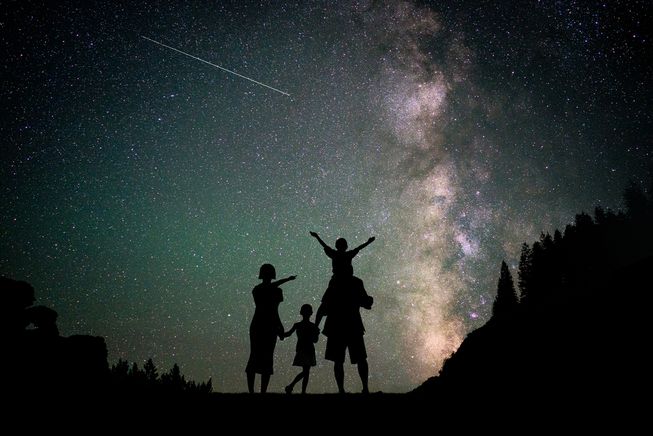I’ve Got a Telescope, Now What? A Beginner’s Guide to Astronomy
Want to know more? Stay up to date with our FREE monthly emails here.
Everything told us a beginner shouldn’t buy a telescope. But what if it’s too late?
What if we already did buy a telescope…now what do we do? Here’s our absolute beginner’s guide to astronomy, regardless what kind of telescope you may or may not have. Yet!
The following guide is for educational and entertainment purposes. It contains a few product recommendations with affiliate links that might earn us a commission. Thanks for your support!
“Don’t buy a telescope!”
That’s what everyone says. But wait… That doesn’t make much sense. They’re right of course. Buying a telescope to jump start your hobby is typically the fast lane to storing that telescope in the garage for the next dozen years.
But what if it’s too late? What if we already spent money on a telescope or were lucky enough to have one fall into our lap… now what?!
Well then! You’re just like us here at the Modern Astronomer. We started this adventure with a slightly misshapen light tube and a dream. But even if you haven’t taken the plunge like us this guide will help you all the same.
[sta_anchor id=”section-1″]
STEP I – LEARN THE SKY
What all the guides and other astronomers did tell us was to learn the sky first. Yup, that’s pretty solid advice there.
We didn’t listen. We toted our scope outside the first sorta-dark night we had and swore we were going to show off how awesome space was. We just had to find something cool first.
Except in the dark, with all that pressure, we had no idea what we were looking at. Was that the big dipper? Or is that it?
Crap.
Well, there’s always the moon. Then we’d take forever to finally find the blasted rock, get it into focus and try to show it off before it slipped out of frame. What started as an adventure ended in frustration and the telescope becoming just another decoration in our den.
The easiest way to learn the sky is to…look at it.
Take a look up the next night you’re outside.
There are bright stars and dim stars, twinkling stars and planets. Some are planets and some are airplanes. Depending on how dark the skies are around you, you might notice star clusters like Pleiades and the fuzzy heart of our own galazy.
The more you look the more you’ll notice how those tiny points of light start to cluster together and make shapes.
Using a planisphere or star chart app (link to story) we can start to put some names to these shapes. Those are constellations and there’s a lot of them. Eighty-eight to be exact. It’s a little overwhelming, but not impossible.
Want to know what we did to start showing off our sky knowledge? Try this:

First, find the Big Dipper.
Once you find it you’ll always be able to notice it even in bright skies light polluted skies. It is one of the most recognizable constellations in the sky. It is part of a much larger constellation called Canis Major or the “Great Bear”.
From here on we will use it as our anchor as we sail across the sky.

The two stars that make up the end of the bucket of Canis Major point directly at the north star, or Polaris as it’s friends call it. It isn’t the brightest star in the sky but its very important. You’ll notice that the stars tend to drift out of a telescope’s eyepiece. This is due to the rotation of the earth. The North star is so named because it sits roughly above the North Pole and doesn’t rotate in the sky. Find it?
Now that we’re on Polaris, we’re also on the handle of the Little Dipper!

Now, our friend the hunter, Orion.
Orion is pretty easy to find once you learn his shape. And notice his belt. And sword. That fiercely orange star on his shoulder is Betelgeuse. It’s big. Really, really big.

You can see where the planets are in the sky above you by clicking this link.
Planets don’t twinkle like the stars do because the light from the planets is much closer and doesn’t get distorted by the Earth’s atmosphere. Venus, sometimes called the “Morning Star” is usually only visible in the early morning or early night close to the sun because it orbits closer than we do.

Finally, the Milky Way.
This is the center of our galaxy. Although we don’t know for sure what our home looks like, scientists have deduced we are a giant spiral galaxy.
In the darkest skies it really can look like the pictures. It’s bright because it is full of stars. Way too many to actually look at separately. There’s a giant black hole out there somewhere too, eating away the darkness. Spooky.
The time devoted to learning these guideposts in the stars will make finding the darker and more elusive targets easier when we use our scope.
[sta_anchor id=”section-2″]
STEP II – GOING TO AN STAR PARTY
When a bunch of amateur astronomers mysteriously gather in the same general location with their telescopes at night, we call it a star party. Ok, that might not be the true definition but it’s close.
Star parties give new and inexperienced stargazers a chance to learn and play with big telescopes under the watchful supervision of grizzled veterans. For those that don’t have their own telescope, this might be the first time putting a pupil to the eyepiece. Or the first time seeing things through a real telescope.
For certain, these free events let our budding astronomer get familiar with spotting and tracking celestial objects and begin to see the different between planets and other heavenly bodies while being guided by a pro.
Certain observatories scattered through the country offer public viewings and star parties which give both novice and veteran amateur astronomers a chance to play with a really, really big light bucket. Like the 100-inch monster at Mount Wilson Observatory in Los Angeles.
Eventually peeking through someone else’s telescope is going to get old. That’s when you know it’s time…
[sta_anchor id=”section-3″]
STEP III – BUY THAT TELESCOPE. FINALLY.
So if you are not like us and you haven’t made your first telescope purchase… what are you waiting for!?
By now we’re know where the planets are and how to find the Big Dipper. When we lug our telescope out and set it up we already have a few targets in mind. And we can find them!
If you haven’t bought a telescope yet, well we have a guide for you.
However, if you don’t feel like reading anymore long diatribes on astronomy, then we recommend the Orion SkyQuest XT8 Classic Dobsonian. It’s a giant light bucket reflector with a Dobsonian mount that makes tracking and finding deep sky targets easy. It’s simple, no frills and has an awesome focuser that allows for any size eyepiece.
It’s the defacto go to first telescope for those that really want to get serious about the hobby. Not sure? Then just to be sure, head over to the telescope buyers guide. We’ll wait.
[sta_anchor id=”section-4″]
STEP IV – WHAT ELSE DO I NEED?
We have a telescope and our growing night sky knowledge but there are a few more things that would make it a little better. Perfect even.
Like we mentioned before, a hand held planisphere or a smartphone app will make identifying objects much easier. They will tell you exactly what constellations and stars are above you at any given time. Check out the augmented reality features of sky app here. Just point your phone at the sky and the app will tell you what you’re looking at based on your GPS location!
We also use a special astronomer’s flashlight to preserve our night vision. The red light works by allowing us to see without contracting our pupils. Tiny pupils means less light gets into our eyes. Shun the bright lights!
Finally, to round everything out, we have a guide to upgrade those stock eyepieces that came with your new scope we bought a few paragraphs ago.
Phew, there we go.
That is the first big step to becoming the Modern Astronomer. The key is to ease into the hobby so that it remains enjoyable. Taking it slow helps to stave off the frustration that comes when barreling head first into astronomy without a plan or a clue. Discovery is human nature and what we see through the telescope truly is the final frontier.
As always, we wish you dark skies and cloudless nights!
Email sign up and additional story for affiliate links.




6tq7ro
azhquu
vjuz5m